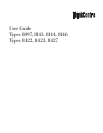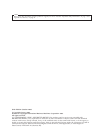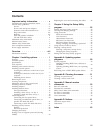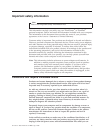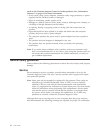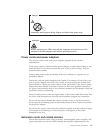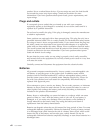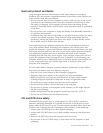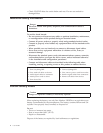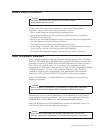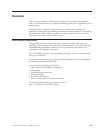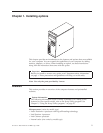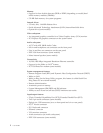Heat and product ventilation
Computers generate heat when turned on and when batteries are charging.
Notebook PCs can generate a significant amount of heat due to their compact size.
Always follow these basic precautions:
v Do not leave the base of your computer in contact with your lap or any part of
your body for an extended period when the computer is functioning or when
the battery is charging. Your computer produces some heat during normal
operation. Extended contact with the body could cause discomfort or, potentially,
a skin burn.
v Do not operate your computer or charge the battery near flammable materials or
in explosive environments.
v Ventilation slots, fans and/or heat sinks are provided with the product for safety,
comfort, and reliable operation. These features might inadvertently become
blocked by placing the product on a bed, sofa, carpet, or other flexible surface.
Never block, cover or disable these features.
You
should inspect your desktop computer for dust accumulation at least once
every three months. Before inspecting your computer, turn off the power and
unplug the computer’s power cord from the electrical outlet; then remove any dust
from vents and perforations in the bezel. If you notice external dust accumulation,
you should also examine and remove dust from the inside of the computer
including heat sink inlet fins, power supply vents, and fans. Always turn off and
unplug the computer before opening the cover. If possible, avoid operating your
computer within 2 feet of high-traffic areas. If you must operate your computer in
or near a high-traffic area, you should inspect and, if necessary, clean your
computer more frequently.
For your safety and to maintain optimum computer performance, always follow
these basic precautions with your desktop computer:
v Keep the cover closed whenever the computer is plugged in.
v Regularly inspect the outside of the computer for dust accumulation.
v Remove dust from vents and any perforations in the bezel. More frequent
cleanings might be required for computers in dusty or high-traffic areas.
v Do not block or restrict airflow into the front of the computer.
v Do not block the airflow vents on the back of the computer.
v Do not store or operate your computer inside furniture, as this might increase
the risk of overheating.
v Airflow temperatures into the computer should not exceed 35° C (95° F).
v Do not use non-ThinkCentre air filtration devices.
CD and DVD drive safety
CD and DVD drives spin discs at a high speed. If a CD or DVD is cracked or
otherwise physically damaged, it is possible for the disc to break apart or even
shatter when the CD drive is in use. To protect against possible injury due to this
situation, and to reduce the risk of damage to your machine, do the following:
v Always store CD/DVD discs in their original packaging
v Always store CD/DVD discs out of direct sunlight and away from direct heat
sources
v Remove CD/DVD discs from the computer when not in use
v Do not bend or flex CD/DVD discs, or force them into the computer or their
packaging
Important safety information ix



